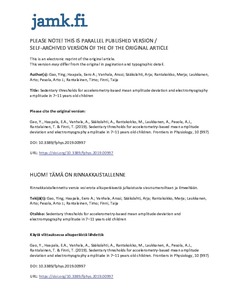Sedentary thresholds for accelerometry-based mean amplitude deviation and electromyography amplitude in 7–11 years old children
Gao, Ying; Haapala, Eero A.; Vanhala, Anssi; Sääkslahti, Arja; Rantakokko, Merja; Laukkanen, Arto; Pesola, Arto J.; Rantalainen, Timo; Finni, Taija (2019)
Gao, Ying
Haapala, Eero A.
Vanhala, Anssi
Sääkslahti, Arja
Rantakokko, Merja
Laukkanen, Arto
Pesola, Arto J.
Rantalainen, Timo
Finni, Taija
Frontiers Research Foundation
2019
Julkaisun pysyvä osoite on
https://urn.fi/URN:NBN:fi-fe2019081924670
https://urn.fi/URN:NBN:fi-fe2019081924670
Tiivistelmä
We investigated the ability of energy expenditure, movement sensing, and muscle activity to discriminate sedentary and non-sedentary activities in children. Thirty-five 7–11-year-old children participated in the study. Simultaneous assessment of oxygen uptake (V̇O2), triaxial accelerometry, and thigh muscle electromyography (EMG) were performed during eight different sedentary and non-sedentary activities including lying down, sitting-, standing-, and walking-related activities, which were performed in a random order. Mean values of V̇O2, accelerometry, and EMG from the concurrent 2 min epochs during each activity were computed. Resting energy expenditure (REE) was measured during 30 min supine rest. Directly measured metabolic equivalent of tasks (METs, V̇O2 in activities/V̇O2 in REE) were calculated for each activity. Mean amplitude deviation (MAD) was computed for accelerometry. EMG was normalized for mean muscle activity during self-paced walking. The classification accuracy of METs, MAD, and EMG to discriminate sedentary activities from physical activities was investigated by receiver operating characteristic curves and optimal cut-offs based on maximal sensitivity and specificity. Mean (SD) REE was 5.0 ± 0.8 ml/kg/min. MET, MAD, and EMG values ranged from 1.0 to 4.9, 0.0020 to 0.4146 g, and 4.3 to 133.9% during lying down and walking at 6 km/h, respectively. Optimal cut-offs to discriminate sedentary activities from non-sedentary activities were 1.3 for METs (sensitivity = 82%, specificity = 88%), 0.0033 g for MAD (sensitivity = 80%, specificity = 91%), and 11.9% for EMG (sensitivity = 79%, specificity = 92%). In conclusion, this study provides applicable thresholds to differentiate sitting and standing and sedentary and non-sedentary activities based on METs, MAD, and EMG in young children.
